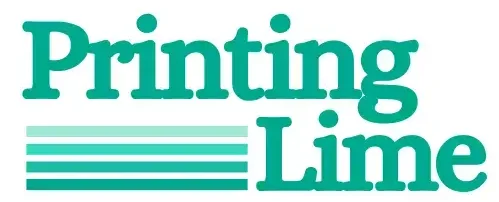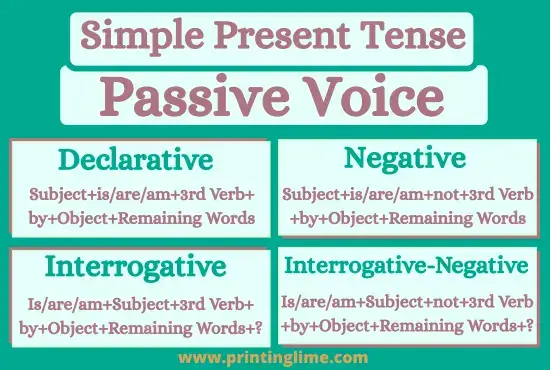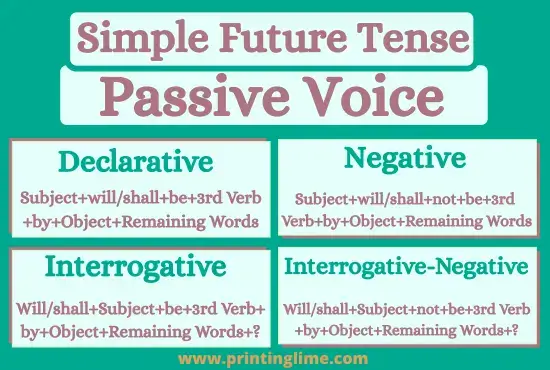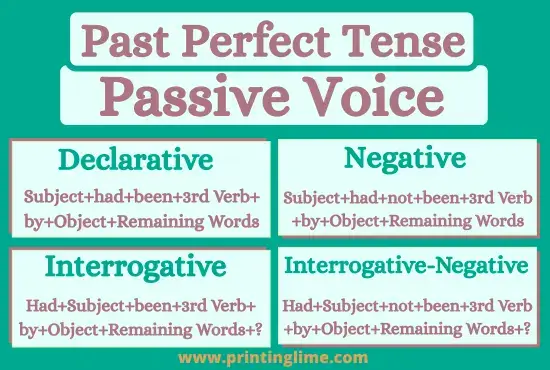Present Continuous Tense (Passive Voice)

All the active voice sentences of Present Continuous Tense can be convertible to Passive Voice form. “Is/are/am” is used as helping Verbs along with “being” to show the passive present time progressive actions.
Present Continuous Tense Passive Voice Rules
Following are some general rules of making sentences of Present Continuous Tense Passive Voice.
- At first, convert the “Object” of Active Voice Sentence into the “Subject” of Passive Voice sentence.
- Then use helping verb “is being/are being/am being”, with respective nouns and pronouns.
- Then, use 3rd Verb to show that action is being done.
- After that use preposition “by” to show the doer of action.
- Then, convert the “Subject” of active voice sentence into the “object” of passive voice sentence.
Helping Verbs of Present Continuous Tense Passive Voice
Passive Voice Sentences of Present Continous Tense use following 3 helping verbs with respective singular and plural nouns and pronouns.
“Am being” As An Helping Verb in Present Continuous Tense Passive Voice Sentences
“Am being” is used as an helping verb with only “I” to show the passive progressive actions of the present time. Thus, these passive sentences with “am being” as helping verb has the following sentence formula.
I+ am+ being+ 3rd Verb+ by + Object+ Remaining Words

Following are some examples of Present Continuous Tense Passive Voice with “is being” as the helping verb.
- My teacher is teaching me.
- I am being taught by my teacher.
- Someone is watching me.
- I am being watched by someone.
- My friend is helping me.
- I am being helped by my friend.
- The manager is interviewing me.
- I am being interviewed by the manager.
- The doctor is calling me.
- I am being called by the doctor.
“Are being” As An Helping Verb in Present Continuous Tense Passive Voice Sentences
“Are being” is used as an helping verb with plural nouns and pronouns (we/you/they) to show the present passive progressive actions. These progressive sentences in passive voice form with “are being” ashelping verb has the following sentence structure formula.
We/you/they/plural noun+ are+ being+ 3rd Verb+ by+ Object+ Remaining Words
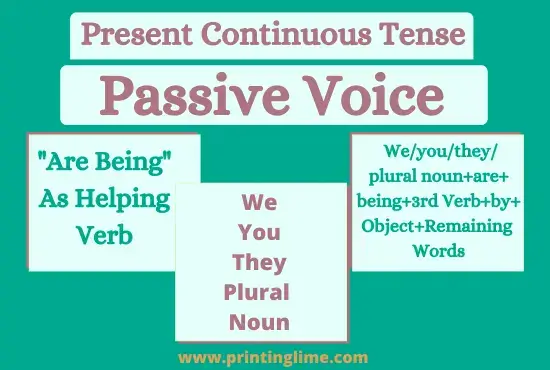
“Are being” is in following Present Continuous Tense passive voice sentences with “we,” “you,” and “they”.
- Our teacher is guiding us.
- We are being guided by our teacher.
- The waiter is serving you.
- You are being served by the waiter.
- The coach is training them.
- They are being trained by the coach.
- The manager is informing us.
- We are being informed by the manager.
- The host is inviting them.
- They are being invited by the host.
“Is being” As An Helping Verb in Present Continuous Tense Passive Voice Sentences
“Is being” is used as an helping verb with singular nouns and pronouns (he/she/it), with 3rd verb to express the progressive passive actions of the present time. Thus, Present Continuous Tense(Passive Voice) sentences with “is being” has the following general sentence formula.
He/she/it/singular noun+ is+ being+ 3rd Verb+ by+ Object+ Remaining Words

Following are some examples of the present continuous tense passive voice having “is being” wih singular number of nouns and pronouns (he/she/it).
- Everyone is praising him.
- He is being praised by everyone.
- Her mother is teaching her.
- She is being taught by her mother.
- The mechanic is repairing it.
- It is being repaired by the mechanic.
- The police are watching him.
- He is being watched by the police.
- The principal is calling her.
- She is being called by the principal.
Present Continuous Tense Passive Voice Sentences Formula
Following are sentence formula for Declarative, Negative, Interrogative, and Interrogative-Negative sentences of Present Continuous Tense (Passive Voice). These sentences are used to show the assertion, negative, interrogative, and interrogative-negative nature of the passive continuous actions.
Declarative Sentence Formula of Present Continuous Tense Passive Voice
Declarative sentences of Present Continuous Tense (Passive Voice) is used to indicate assertive, declarative progressive actions and also use to give statements about the prgressive state. These sentences have the following sentence strutural formula.
Subject+ is/are/am+ being+ 3rd Verb+ by+ Object+ Remaining Words

Declarative Sentences of Present Continuous Tense Passive Voice Examples
Following are some examples of declarative sentences of Present Continuous Tense Passive Voice.
- My tutor is teaching me.
- I am being taught by my tutor.
- Our leader is guiding us.
- We are being guided by our leader.
- The chef is serving you.
- You are being served by the chef.
- The HR manager is interviewing them.
- They are being interviewed by the HR manager.
- The doctor is treating him.
- He is being treated by the doctor.
- Her friends are helping her.
- She is being helped by her friends.
- The maid is cleaning it.
- It is being cleaned by the maid.
- The mechanic is repairing the car.
- The car is being repaired by the mechanic.
- The librarian is arranging the books.
- The books are being arranged by the librarian.
- The gardener is watering the garden.
- The garden is being watered by the gardener.
Negative Sentence Formula of Present Continuous Tense Passive Voice
Negative Sentences of Present Continuous Tense(Passive Voice) take “not” between helping verbs “is/are/am” and “being” in order to show the negative passive action. These negative sentences have the following general structural formula.
Subject+ is/are/am+ not+ being+ 3rd Verb+ by+ Object+ Remaining Words
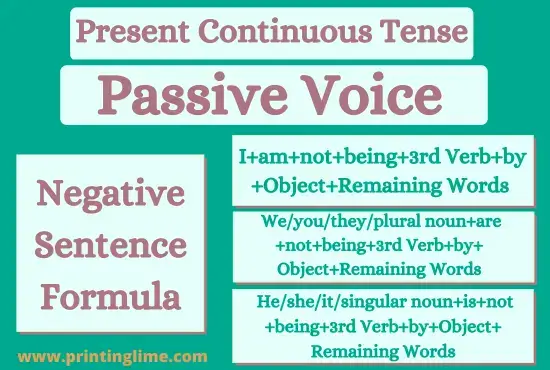
Negative Sentences of Present Continuous Tense Passive Voice Examples
Following are some Negative Sentence examples of Present Continuous Tense (Passive Voice).
- My friend is not helping me.
- I am not being helped by my friend.
- Our teacher is not teaching us today.
- We are not being taught by our teacher today.
- They are not inviting you.
- You are not being invited by them.
- The manager is not guiding them.
- They are not being guided by the manager.
- His team is not trusting him.
- He is not being trusted by his team.
- The guards are not watching her.
- She is not being watched by the guards.
- The mechanic is not repairing it.
- It is not being repaired by the mechanic.
- The worker is not cleaning the car.
- The car is not being cleaned by the worker.
- The librarian is not arranging the books.
- The books are not being arranged by the librarian.
- Their parents are not taking the children to the park.
- The children are not being taken to the park by their parents.
Interrogative Sentence Formula of Present Continuous Tense Passive Voice
Interrogative Sentences of Present Continuous Tense (Passive Voice) takes “is/are/am” at the start of sentences to show the interrogative nature of passive progressive actions. However, “being” comes after the subject of passive voice sentence. These negativesentences have the following general structural formula.
Is/are/am+ Subject+ being+ 3rd Verb+ by+ Object+ Remaining words+?
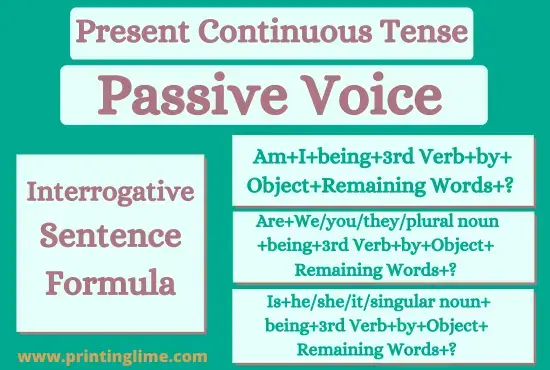
Interrogative Sentences of Present Continuous Tense Passive Voice Examples
Following are some examples of Present Continuous Tense (Passive Voice) Interrogative Sentences.
- Is the new instructor teaching me?
- Am I being taught by the new instructor?
- Is the principal inviting us?
- Are we being invited by the principal?
- Are your classmates helping you?
- Are you being helped by your classmates?
- Is the coach training them?
- Are they being trained by the coach?
- Are the police questioning him?
- Is he being questioned by the police?
- Is everyone praising her?
- Is she being praised by everyone?
- Is the technician repairing it?
- Is it being repaired by the technician?
- Are the workers painting the house?
- Is the house being painted by the workers?
- Is the manager checking the files?
- Are the files being checked by the manager?
- Is the teacher giving homework to the students?
- Are the students being given homework by the teacher?
- Is homework being given to the students by the teacher?
Interrogative-Negative Sentence Formula of Present Continuous Tense Passive Voice
Interrogative-Negative Sentences of Present Continuous Tense(Passive Voice) take “is/are/am” at the start of sentences to show the interrogative nature of passive progressive actions of the present time. And “not being” comes after the subject of passivevoice sentence. These interrogative-negative sentences have the following sentence structural formula.
Is/are/am+ Subject+ not+ being+ 3rd Verb+ by+ Object+ Remaining Words+?
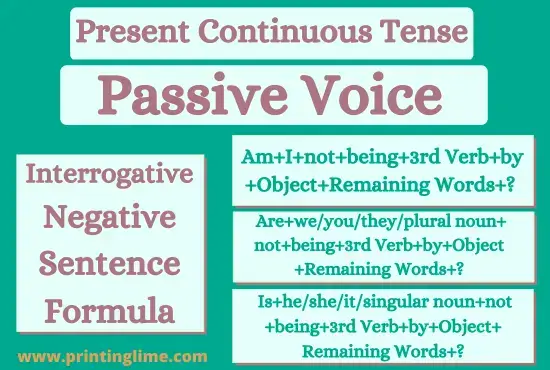
Interrogative-Negative Sentences of Present Continuous Tense Passive Voice Examples
Following are some examples of Interrogative-Negative sentences of Present Continuous Tense (Passive Voice).
- Is the teacher not helping me?
- Am I not being helped by the teacher?
- Is the manager not guiding us?
- Are we not being guided by the manager?
- Are your friends not inviting you?
- Are you not being invited by your friends?
- Is the coach not training them?
- Are they not being trained by the coach?
- Are the police not questioning him?
- Is he not being questioned by the police?
- Are her parents not praising her?
- Is she not being praised by her parents?
- Is the mechanic not repairing it?
- Is it not being repaired by the mechanic?
- Is the maid not cleaning the room?
- Is the room not being cleaned by the maid?
- Is the officer not checking the documents?
- Are the documents not being checked by the officer?
- Is the gardener not watering the flowers?
- Are the flowers not being watered by the gardener?
